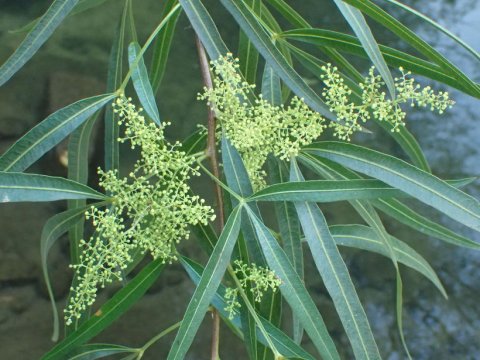Climate Matching Map
| Attachment | Size |
|---|---|
| climatematch-searsia_lancea-arizona-20251031.pdf (1.03 MB) | 1.03 MB |
1. Question 1
The species has a moderate to high invasive potential in urban areas and surrounding riparian habitats. Basically, seedlings can germinate anywhere there is constant or seasonal sources of water (Martin, 2021). This commonly cultivated shade tree is quite invasive and can now be found growing wild in washes and along canyon streams in the deserts around Tucson (Kinsey, 2021).
Online herbarium specimen records further clarify occurrences in the Phoenix and Tucson areas:
Herbarium specimen: Locality: USA, Arizona, Maricopa, Cave Creek; 'Jewel of the Creek' at Spur Cross Ranch,
Desert Foothills Land Trust; just upstream of where hiking trail crosses the creek; small
ephemeral wash coming in from the east. 33.8917 -111.95214 WGS84 Elevation: 710 meters Verbatim
(SEINet, 2021 2021. http//:swbiodiversity.org/index.php. Accessed on June 14)
Herbarium specimen: Locality: United States, Arizona, Maricopa, N side of South Mountain Park, Phoenix
33.3555 -112.065 Verbatim Coordinates
(SEINet, 2021 2021. http//:swbiodiversity.org/index.php. Accessed on June 14)
Herbarium specimen: Locality: U.S.A., Arizona, Pima, Major drainage running parallel to Sweetwater Trail,
Tucson Mountains, Saguaro National Park
32.2700572 -111.13383241 +-5m. NAD83
Elevation: 1040 meters Verbatim Elevation: 3400 ft.
Habitat: Rocky bank of drainage
Substrate: Gravelly soil
Associated Species: Encelia farinosa
Description: One small sapling, maybe 0.75 m. tall
Reproductive Condition: Non-reproductive
Notes: Likely introduced by a bird. Cultivated plants noted in adjacent neighborhood.
(SEINet, 2021 2021. http//:swbiodiversity.org/index.php. Accessed on June 14)
Searsia lancea is documented as naturalized in California. A catalogue of 315 non-native vascular plant taxa documented as occurring spontaneously in beyond those addressed in The Jepson Manual: Higher Plants of California is presented, compiled from new collections by the authors and others, previously existing herbarium formal publications, other printed reports, and direct communications with field botanists. Rhus lancea listed as Naturalization class N: naturalized (outside of wetlands). (Hrusa et. al. 2021).
Searsia lancea is documented as naturalized in India. Negi & Hajra (2007) list Rhus lancea as an exotic of the Doon Valley.
Searsia lancea is documented as naturalized in Australia, in far western New South Wales (WeedWise, NSW, 2018).
2. Question 2
3. Question 3
4. Question 4
5. Question 5
6. Question 6
7. Question 7
8. Question 8
9. Question 9
Listed by (Wells, 1986) as having undesirable characteristics: contaminant: seed. But the seed is not reported as poisonous. The leaves and fruit are eaten by wild animals and livestock (Stern, 2008).
10. Question 10
11. Question 11
12. Question 12
13. Question 13
African sumac has a moderate to high invasive potential in urban areas and surrounding riparian habitats. Basically, seedlings can germinate anywhere there is constant or seasonal sources of water (Martin, 2021).
14. Question 14
15. Question 15
Basically, seedlings can germinate anywhere there is constant or seasonal sources of water (Martin, 2021).
16. Question 16
17. Question 17
18. Question 18
19. Question 19
20. Question 20
Fruit: Small (up to 3/16 inch diameter), round, slightly flattened yellow or red wrinkled drupes grow in clusters; fruit contains small black seeds (USDA, 2021). The fruit and seed have no obvious structures for mechanical dispersal (Becking, 2021).
Evaluation Notes
Difficult to say if plant produces "copious amounts of seeds." This plant can become a large tree and may possibly do this at large size, but might not when smaller.
Plant's seeds may move with water as the tree can occur along waterways. Perhaps not likely to transport long distance as desert waterways characteristic of this area are ephemeral with limited flow, but also subject to periodic flash-floods.
Added updated climate match map and link but did not proof answer to #6. Also made minor typographical corrections to references for new website. (10/31/2025 J. Burger)






